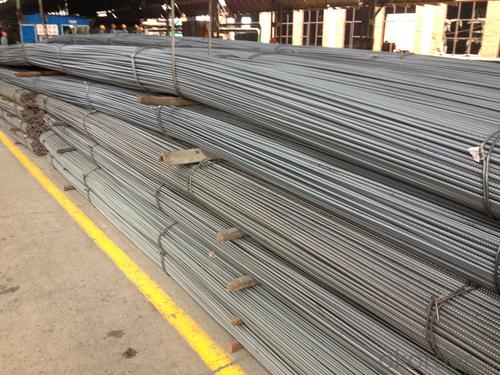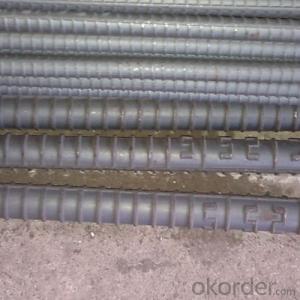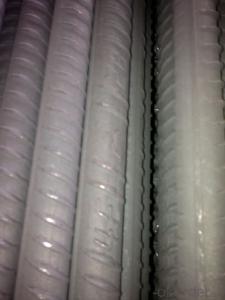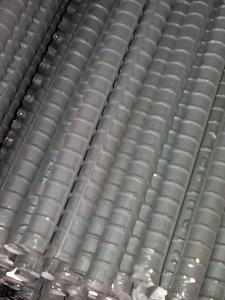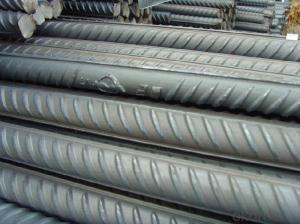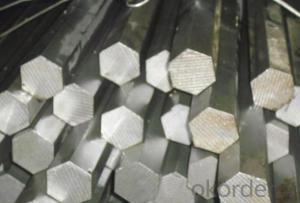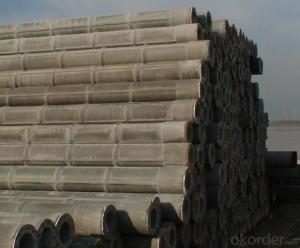Different Material Hot Rolled Dedormed Steel Rebar
- Loading Port:
- China main port
- Payment Terms:
- TT or LC
- Min Order Qty:
- 50 m.t.
- Supply Capability:
- 200000 m.t./month
OKorder Service Pledge
OKorder Financial Service
You Might Also Like
Specifications of Different Material Hot Rolled Dedormed Steel Rebar
Standard | GB | HRB500 | |
Diameter | 6mm,8mm,10mm,12mm,14mm,16mm,18mm,20mm, 22mm,25mm,28mm,32mm,36mm,40mm,50mm | ||
Length | 6M, 9M,12M or as required | ||
Payment term | TT or L/C | ||
Application | mainly used in construction industry to reinforce concrete structures and so on | ||
Quality | First quality, the goods are from Chinese big manufacturers. | ||
Type | Hot rolled deformed steel bar | ||
Brand name | DRAGON | ||
Chemical Composition of Different Material Hot Rolled Dedormed Steel Rebar
(Please kindly find our chemistry of our material based on HRB500 as below for your information)
Grade | Technical data of the original chemical composition (%) | ||||||
C | Mn | Si | S | P | V | ||
HRB500 | ≤0.25 | ≤1.60 | ≤0.80 | ≤0.045 | ≤0.045 | 0.08-0.12 | |
Physical capability | |||||||
Yield Strength (N/cm²) | Tensile Strength (N/cm²) | Elongation (%) | |||||
≥500 | ≥630 | ≥12 | |||||
Theoretical weight and section area of each diameter as below for your information:
Diameter(mm) | Section area (mm²) | Mass(kg/m) | Weight of 12m bar(kg) |
6 | 28.27 | 0.222 | 2.664 |
8 | 50.27 | 0.395 | 4.74 |
10 | 78.54 | 0.617 | 7.404 |
12 | 113.1 | 0.888 | 10.656 |
14 | 153.9 | 1.21 | 14.52 |
16 | 201.1 | 1.58 | 18.96 |
18 | 254.5 | 2.00 | 24 |
20 | 314.2 | 2.47 | 29.64 |
22 | 380.1 | 2.98 | 35.76 |
25 | 490.9 | 3.85 | 46.2 |
28 | 615.8 | 4.83 | 57.96 |
32 | 804.2 | 6.31 | 75.72 |
36 | 1018 | 7.99 | 98.88 |
40 | 1257 | 9.87 | 118.44 |
50 | 1964 | 15.42 | 185.04 |
Usage and Applications of Different Material Hot Rolled Dedormed Steel Rebar
Deformed bar is widely used in buildings, bridges, roads and other engineering construction. Big to highways, railways, bridges, culverts, tunnels, public facilities such as flood control, dam, small to housing construction, beam, column, wall and the foundation of the plate, deformed bar is an integral structure material. With the development of world economy and the vigorous development of infrastructure construction, real estate, the demand for deformed bar will be larger and larger..
Packaging & Delivery of Different Material Hot Rolled Dedormed Steel Rebar
Packaging Detail: products are packed in bundle and then shipped by container or bulk vessel, deformed bar is usually naked strapping delivery, when storing, please pay attention to moisture proof. The performance of rust will produce adverse effect.
Each bundle weight: 2-3MT, or as required
Delivery Detail: within 45 days after received advanced payment or LC.
Label: to be specified by customer, generally, each bundle has 1-2 labels
Trade terms: FOB, CFR, CIF
Picture of Different Material Hot Rolled Dedormed Steel Rebar
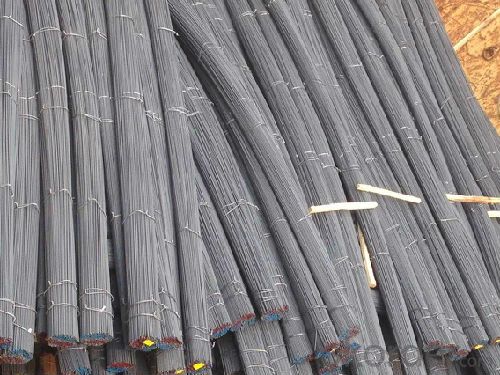
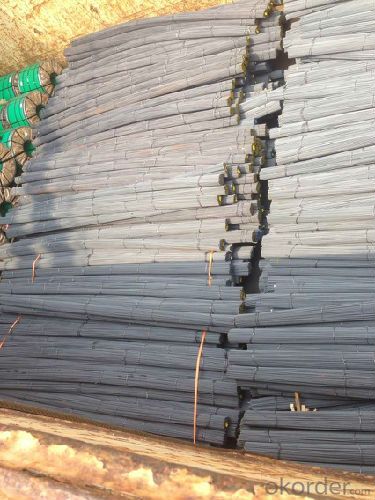
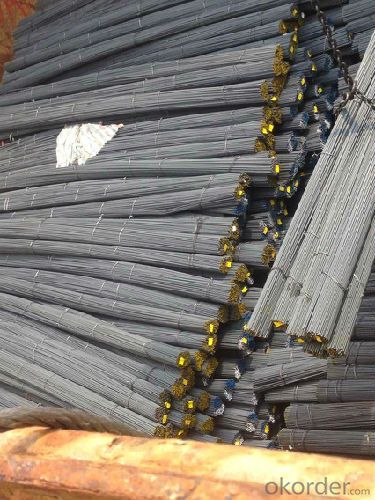
Note:
1. Our products are produced according to national standard (GB), if not, supply according to national standards (GB) or agreement as customer required.
2. Other Grade and Standard Deformed Steel Bar we can supply:
Grade: GR40/GR60, G460B/B500A/B500B/B500C,BST500S
Standard: ASTM, BS, DIN
The Minimum Order Quantity of these products is high, and need to be confirmed.
3. We can not only supply Deformed Steel Bar; if you need anything about building materials, please contact us for further information.
4. Please send us your detail specifications when inquire. We will reply to you as soon as possible. We sincerely hope we can establish a long stable business relationship.
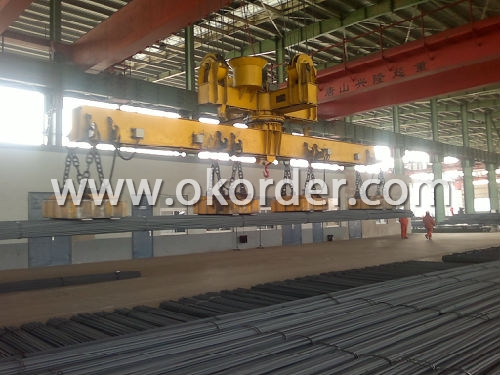
Deformed Steel Bar in testing
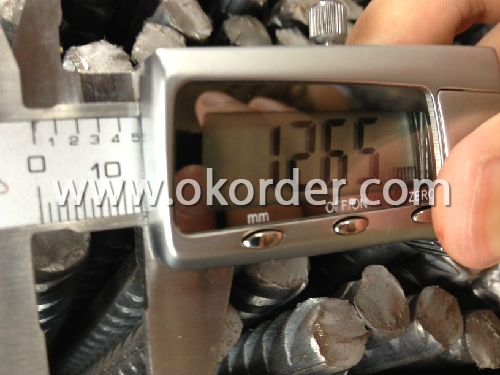
- Q: Why is the threaded steel thread?
- Steel is commonly known as hot rolled ribbed bar, belonging to the small steel steel, mainly used for steel reinforced concrete structure frame. In use, some mechanical strength, bending deformation property and welding performance are required.
- Q: What are the guidelines for the proper anchoring of steel rebars in walls?
- The proper anchoring of steel rebars in walls is crucial to ensure the structural integrity and stability of the construction. Here are some guidelines to follow for the correct anchoring of steel rebars in walls: 1. Determine the required rebar size and spacing: The size and spacing of rebars depend on the design specifications and load requirements. Consult the structural engineer or refer to the building codes for the appropriate rebar size and spacing. 2. Clean and prepare the concrete surfaces: Before anchoring the rebars, ensure that the concrete surfaces are clean, free from dust, debris, and any loose material. Use a wire brush or compressed air to remove any contaminants. 3. Use proper anchoring techniques: The most common method for anchoring steel rebars in walls is by embedding them into the concrete. Ensure that the rebars are securely embedded by following these steps: a. Drill holes: Drill holes in the concrete wall at the specified locations and depths, ensuring that the diameter of the hole matches the rebar size. b. Clean the drilled holes: Remove any dust or debris from the drilled holes using compressed air or a brush. c. Insert rebars: Insert the rebars into the drilled holes, making sure they reach the required embedment depth. d. Proper spacing: Maintain the specified spacing between rebars based on the design requirements. e. Secure rebars: Use appropriate anchoring materials like epoxy resin or grout to secure the rebars in place. Follow the manufacturer's instructions for mixing and applying the anchoring material. f. Ensure proper alignment: Verify that the rebars are correctly aligned, both horizontally and vertically, before the anchoring material sets. 4. Allow sufficient curing time: After anchoring the rebars, allow sufficient time for the anchoring material to cure. This ensures that the rebars are firmly secured in place. 5. Properly protect the rebars: Once the rebars are anchored, protect them from corrosion by applying a suitable corrosion-resistant coating or using corrosion-resistant rebars. It is essential to follow these guidelines, as improper anchoring of steel rebars can compromise the structural integrity of the walls and pose safety risks. Always consult with a qualified structural engineer or building professional for specific guidelines tailored to your project.
- Q: How do steel rebars affect the workability of concrete?
- Steel rebars can have a significant impact on the workability of concrete. Firstly, the presence of steel rebars in concrete helps to increase its strength and structural integrity. The rebars act as reinforcement by absorbing and redistributing tensile forces, preventing the concrete from cracking or collapsing under load. However, the addition of steel rebars also affects the workability of concrete in several ways. Firstly, the presence of rebars reduces the workability or slump of the concrete mix. This means that the concrete becomes less fluid and more difficult to handle, especially during pouring and placement. The rebars create obstacles and hinder the flow of concrete, requiring more effort to properly place and compact the mixture. Furthermore, the presence of steel rebars can lead to issues such as segregation and segregation of concrete. Segregation occurs when the heavier rebars cause the aggregate to settle at the bottom, resulting in an uneven distribution of components in the mixture. This can affect the strength and durability of the concrete. Moreover, the presence of rebars may require additional measures to ensure proper bond between the steel and concrete. Adequate cover depth and proper placement of rebars are crucial to ensure that the rebars are fully embedded in the concrete, providing the necessary reinforcement. Failing to achieve proper bond can compromise the strength and structural integrity of the concrete. In conclusion, steel rebars have both positive and negative effects on the workability of concrete. While they enhance the strength and durability of the concrete, they also reduce its workability and require additional considerations during the mixing and placement process. Proper planning and execution are necessary to ensure that the rebars are incorporated effectively and do not hinder the overall workability and performance of the concrete.
- Q: How long do steel rebars last in a concrete structure?
- Steel rebars can last for several decades in a concrete structure, typically up to 50-100 years or even longer, depending on various factors such as the quality of steel used, environmental conditions, maintenance practices, and exposure to corrosive elements.
- Q: Can steel rebars be used in wind turbine foundation construction?
- Yes, steel rebars can be used in wind turbine foundation construction. Rebars are commonly used in the construction industry to reinforce concrete structures and provide added strength and durability. In wind turbine foundation construction, steel rebars are typically embedded within the concrete to provide structural support and prevent cracking or failure. The rebars help distribute the load and forces exerted by the wind turbine, ensuring the stability and longevity of the foundation. Additionally, steel rebars have high tensile strength, making them suitable for withstanding the dynamic forces and vibrations experienced by wind turbines. Therefore, the use of steel rebars in wind turbine foundation construction is a common and effective practice.
- Q: How are steel rebars inspected for quality on construction sites?
- In construction projects, steel rebars play a critical role by providing reinforcement and strength to concrete structures. It is crucial to ensure the quality of steel rebars in order to guarantee the safety and durability of the overall construction. To inspect the quality of steel rebars on construction sites, various methods are commonly used. The first and most basic method of quality inspection is visual examination. This involves visually inspecting the rebars for any visible defects such as cracks, deformations, rust, or surface irregularities. Any rebars with such flaws are immediately identified and rejected. Another method involves measuring and checking the dimensions of the rebars. Inspection personnel use measuring tools like calipers or tape measures to verify the length, diameter, and other dimensions of the rebars. Any deviation from the specified tolerances may result in rejection. Magnetic Particle Testing (MPT) is a non-destructive testing method that is commonly employed to detect surface and near-surface defects in steel rebars. In this technique, the rebar is magnetized and ferromagnetic particles are applied, which accumulate at any surface defects or cracks. Trained inspectors carefully examine the surface to identify any areas of concern. Ultrasonic Testing (UT) is another non-destructive testing method used for inspecting rebars. It involves transmitting ultrasonic waves through the rebar. These waves reflect back differently when they encounter defects like voids, cracks, or inclusions. Trained technicians analyze the reflected waves to identify and assess the quality of the rebars. Tensile Testing is carried out to determine the tensile strength of the rebars, which is crucial in assessing their quality. A sample rebar is pulled until it breaks, and the force required to do so is measured. This test helps determine the strength and ductility of the rebar, ensuring it meets the required standards. Chemical analysis is often conducted on steel rebars to ensure they meet the specified composition requirements. Samples are collected from the rebars, and various tests are performed to determine the chemical composition, including carbon, manganese, and other alloying elements. This analysis helps ensure that the rebars possess the necessary properties for the intended application. These inspection methods are typically carried out by qualified and experienced personnel, such as certified welding inspectors or quality control technicians. By implementing these quality inspection procedures, construction sites can ensure that the steel rebars used in their projects meet the required standards, thereby ensuring the safety and longevity of the structures being constructed.
- Q: What are the guidelines for using steel rebars in pre-stressed or post-tensioned concrete elements?
- Several key considerations must be taken into account when using steel rebars in pre-stressed or post-tensioned concrete elements to ensure structural integrity and performance. 1. Design and Engineering: The initial step is to consult with a qualified structural engineer who specializes in pre-stressed or post-tensioned concrete design. They will determine the specific project's requirements for rebars, including size, spacing, and type, based on the structural loads, design requirements, and desired performance. 2. Material Selection: The rebars used in pre-stressed or post-tensioned concrete elements should adhere to industry standards, such as ASTM A615 or ASTM A706 for reinforcing steel. The rebars should possess adequate strength, ductility, and corrosion resistance to withstand environmental conditions and stress. 3. Placement and Anchorage: Precise placement and anchoring of the rebars within the concrete elements are necessary. The requirements for placement and anchorage will depend on the project's design and engineering specifications. Proper alignment and secure fastening of the rebars are crucial to ensure effective force transfer to the concrete. 4. Tensioning Process: In pre-stressed concrete elements, the rebars are tensioned before pouring the concrete. Specialized jacks or hydraulic systems are used to apply a predetermined amount of force to the rebars. Careful control of the tensioning force is vital to achieving the desired level of pre-stress without overloading the rebars or damaging the concrete. 5. Post-Tensioning: For post-tensioned concrete elements, the rebars are tensioned after the concrete has hardened. This involves passing the rebars through ducts or sleeves within the concrete and applying tension using hydraulic jacks. The post-tensioning force must be carefully calibrated to achieve the desired structural performance without excessive strain on the rebars or the concrete. 6. Quality Control and Inspection: Throughout the construction process, regular quality control and inspection are essential to ensure compliance with design specifications and industry standards. This includes verifying correct placement, alignment, and tensioning of the rebars, as well as checking for any defects or damage. 7. Maintenance and Durability: Proper maintenance is crucial for the long-term durability and performance of pre-stressed or post-tensioned concrete elements. This may involve periodic inspections, maintaining protective coatings, and addressing corrosion or deterioration promptly. By adhering to these guidelines, construction professionals can ensure the safe and effective use of steel rebars in pre-stressed or post-tensioned concrete elements, resulting in structurally sound and durable concrete structures.
- Q: What are the guidelines for the proper curing of concrete with steel rebars?
- The proper curing of concrete with steel rebars requires adherence to the following guidelines: 1. Moisture: To ensure proper hydration and strength development, it is necessary to maintain moisture during the curing process. However, excessive moisture should be avoided when curing concrete with steel rebars to prevent corrosion and damage. Therefore, it is important to strike a balance between providing sufficient moisture and preventing the accumulation of standing water around the rebars. 2. Covering: During the pouring process, it is crucial to adequately cover the steel rebars with concrete to protect against corrosion. The thickness of the cover should meet the design specifications to ensure adequate strength and durability. 3. Curing time: The curing time for concrete with steel rebars is typically longer than that of plain concrete. This is due to the need for the steel to bond with the concrete and achieve proper adhesion. The recommended curing period may vary depending on factors such as ambient temperature, humidity, and the specific type of steel used. It is important to refer to the project specifications or consult with a structural engineer to determine the appropriate curing time for the specific application. 4. Temperature control: Temperature control is essential during the curing process to ensure uniform hydration and prevent thermal stress. Rapid temperature changes can lead to cracking and compromise the integrity of the concrete. Therefore, it is important to protect the concrete from extreme temperature variations and provide insulation or shading as necessary. 5. Protection from external elements: Concrete with steel rebars must be safeguarded against external elements that can cause damage or corrosion. This includes protection from chloride ions, carbonation, and chemicals. Additional protection can be provided by applying suitable surface coatings or sealants. 6. Inspection and maintenance: Regular inspection and maintenance are vital for ensuring the long-term durability of concrete with steel rebars. It is important to monitor for signs of corrosion, cracking, or deterioration and take appropriate action promptly. This may involve repairing damaged areas, applying protective coatings, or implementing measures to prevent corrosion. By following these guidelines, the proper curing of concrete with steel rebars can be achieved, resulting in a construction material that is structurally sound and durable, capable of withstanding the test of time.
- Q: How do steel rebars contribute to the overall safety of a structure?
- Steel rebars contribute to the overall safety of a structure by providing reinforcement and strength to concrete. They enhance the structural integrity, preventing cracking and failure under heavy loads or during seismic events. Steel rebars also help to distribute and absorb forces, improving the resistance against bending, shearing, and tension. By effectively reinforcing the concrete, steel rebars ensure the durability and longevity of the structure, minimizing the risk of collapse and ensuring the safety of occupants.
- Q: How do steel rebars impact the overall constructability and scheduling of concrete projects?
- Steel rebars have a significant impact on the overall constructability and scheduling of concrete projects. They provide structural reinforcement to concrete, increasing its strength and durability. The inclusion of rebars in the concrete design requires careful planning and coordination, as they need to be accurately positioned and supported within the concrete forms. This process can add complexity to the construction process, potentially affecting the project's timeline. However, rebars ultimately enhance the project's constructability by ensuring the structural integrity of the concrete elements, leading to safer and more reliable structures.
Send your message to us
Different Material Hot Rolled Dedormed Steel Rebar
- Loading Port:
- China main port
- Payment Terms:
- TT or LC
- Min Order Qty:
- 50 m.t.
- Supply Capability:
- 200000 m.t./month
OKorder Service Pledge
OKorder Financial Service
Similar products
Hot products
Hot Searches
Related keywords



